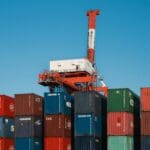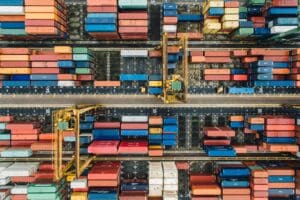Global Trade Compliance Remains on the Rise

Global Trade Compliance Remains on the Rise
 The Global Trade Compliance market is experiencing steady growth and is expected to continue this trend over the next five years. I have recently completed the latest ARC Advisory Market Analysis on Global Trade Compliance, available here. Three major trends are driving growth in this industry which can be attributed to regulatory pressures such as the Uyghur Forced Labor Protection Act, advancements in AI, and supply chain innovations.
The Global Trade Compliance market is experiencing steady growth and is expected to continue this trend over the next five years. I have recently completed the latest ARC Advisory Market Analysis on Global Trade Compliance, available here. Three major trends are driving growth in this industry which can be attributed to regulatory pressures such as the Uyghur Forced Labor Protection Act, advancements in AI, and supply chain innovations.
Driver #1: Navigating a Regulatory Maze
The regulatory landscape is becoming increasingly complex. The U.S. Uyghur Forced Labor Prevention Act (UFLPA) and the European Union’s Forced Labor Regulation (FLR) are prime examples of this tightening framework.
The FLR, published on December 12, 2024, prohibits the sale and export of products made with forced labor in the EU market. Set for full enforcement starting December 14, 2027, it requires companies to ensure that all stages of their supply chains are free from forced labor. It adopts the International Labor Organization’s definition of forced labor and mandates the European Commission to release compliance guidelines by June 2026. Unlike the UFLPA, the FLR applies to all products, regardless of origin, and employs a risk-based approach to assess forced labor risks.
The UFLPA, signed into law on December 23, 2021, specifically targets goods from the Xinjiang Uyghur Autonomous Region (XUAR) in China. Effective June 21, 2022, it establishes a rebuttable presumption that products from XUAR or entities on the UFLPA Entity List are made with forced labor and are therefore barred from entering the U.S. market unless proven otherwise. The law requires importers to provide clear and convincing evidence of a forced-labor-free supply chain and tasks the Forced Labor Enforcement Task Force with devising enforcement strategies.
By 2027, when both the UFLPA and FLR are fully operational, the global supply chain landscape will have transformed significantly. Stricter forced labor regulations, ongoing trade disputes, and the emission reporting mandates of the EU’s Corporate Sustainability Reporting Directive (CSRD) will create immense pressure on companies. Businesses will need to ensure accurate data reporting across core operations such as sourcing, procurement, and transactions. Consequently, demand for robust GTC solutions will continue to rise.
 Adding to the uncertainty, recent comments from a new U.S. administration suggest plans to impose a 25% tariff on products entering the U.S. from Canada and Mexico. Such actions could jeopardize the U.S.-Mexico-Canada Agreement (USMCA), which governs $1.8 trillion in trade. Both Canada and Mexico have vowed to retaliate should these tariffs materialize. Moreover, with the USMCA up for review in two years, the stability of this agreement remains in question. For companies operating in the crosshairs of these geopolitical tensions, preparing for additional trade challenges is not just prudent—it is essential.
Adding to the uncertainty, recent comments from a new U.S. administration suggest plans to impose a 25% tariff on products entering the U.S. from Canada and Mexico. Such actions could jeopardize the U.S.-Mexico-Canada Agreement (USMCA), which governs $1.8 trillion in trade. Both Canada and Mexico have vowed to retaliate should these tariffs materialize. Moreover, with the USMCA up for review in two years, the stability of this agreement remains in question. For companies operating in the crosshairs of these geopolitical tensions, preparing for additional trade challenges is not just prudent—it is essential.
Driver #2: Artificial Intelligence
 Artificial intelligence (AI) has become a cornerstone of recent advancements in this industry, even predating its recent surge in mainstream popularity. Trade classification can be complex and challenging. Efforts to simplify the classification of goods and services are appreciated by potential and existing customers. Several leading suppliers of global trade compliance (GTC) are investing in artificial intelligence (AIR) and machine learning to enhance trade classification capabilities. Some suppliers suggest that a machine learning-driven classification engine may achieve higher accuracy compared to human classification in many situations. Advancements in trade classification for customers ease the process of estimating potential tariffs and reduce the chance of your products taking an unexpected stay at the border. Trade classification lists vary per region and are not universally aligned. This burdensome task can be reduced by the deployment of AI which over time will learn how specific regions categorize products.
Artificial intelligence (AI) has become a cornerstone of recent advancements in this industry, even predating its recent surge in mainstream popularity. Trade classification can be complex and challenging. Efforts to simplify the classification of goods and services are appreciated by potential and existing customers. Several leading suppliers of global trade compliance (GTC) are investing in artificial intelligence (AIR) and machine learning to enhance trade classification capabilities. Some suppliers suggest that a machine learning-driven classification engine may achieve higher accuracy compared to human classification in many situations. Advancements in trade classification for customers ease the process of estimating potential tariffs and reduce the chance of your products taking an unexpected stay at the border. Trade classification lists vary per region and are not universally aligned. This burdensome task can be reduced by the deployment of AI which over time will learn how specific regions categorize products.
AI tools become more valuable when users can comprehend how the AI model arrived at its decisions. Traditional GTC systems could benefit from being supported by a global supply chain knowledge graph, allowing them to expand their services and potentially avoid obsolescence due to newer, advanced solutions. For use cases like tariff calculation, a large data model can be implemented using public cloud architecture with proper permissions. For other applications, such as identifying suppliers in the extended supply chain that engage in forced labor, customers might prefer an approach that combines public data with a company’s proprietary data to create a comprehensive data model.
Driver #3: Supply Chain Innovations
The Supply Chain industry has been undergoing significant changes since 2020, prompting solution providers to adapt their products to navigate these challenging times. Despite facing numerous challenges and setbacks, the industry has seen a wealth of innovations. As new regulations emerge, multitier solutions have had to identify bad actors higher up the supply chain. This has created opportunities for new entrants offering supply chain collaborative network applications to address these issues. To tackle this complex problem, technologies such as AI, data graphs, and digital twins have been utilized.
 Big data sources, including bills of lading and other trade documents, are becoming increasingly crucial as proof points that sub-tier suppliers are not bad actors. There is an overwhelming need for greater transparency across a company’s multi-tier supply chain. The digitalization of supply chains is essential for the future of Global Trade Compliance. As companies embrace digitalization, tracking information transfer and compliance assurance will improve.
Big data sources, including bills of lading and other trade documents, are becoming increasingly crucial as proof points that sub-tier suppliers are not bad actors. There is an overwhelming need for greater transparency across a company’s multi-tier supply chain. The digitalization of supply chains is essential for the future of Global Trade Compliance. As companies embrace digitalization, tracking information transfer and compliance assurance will improve.
The post Global Trade Compliance Remains on the Rise appeared first on Logistics Viewpoints.
January 29, 2025 at 01:36PM
